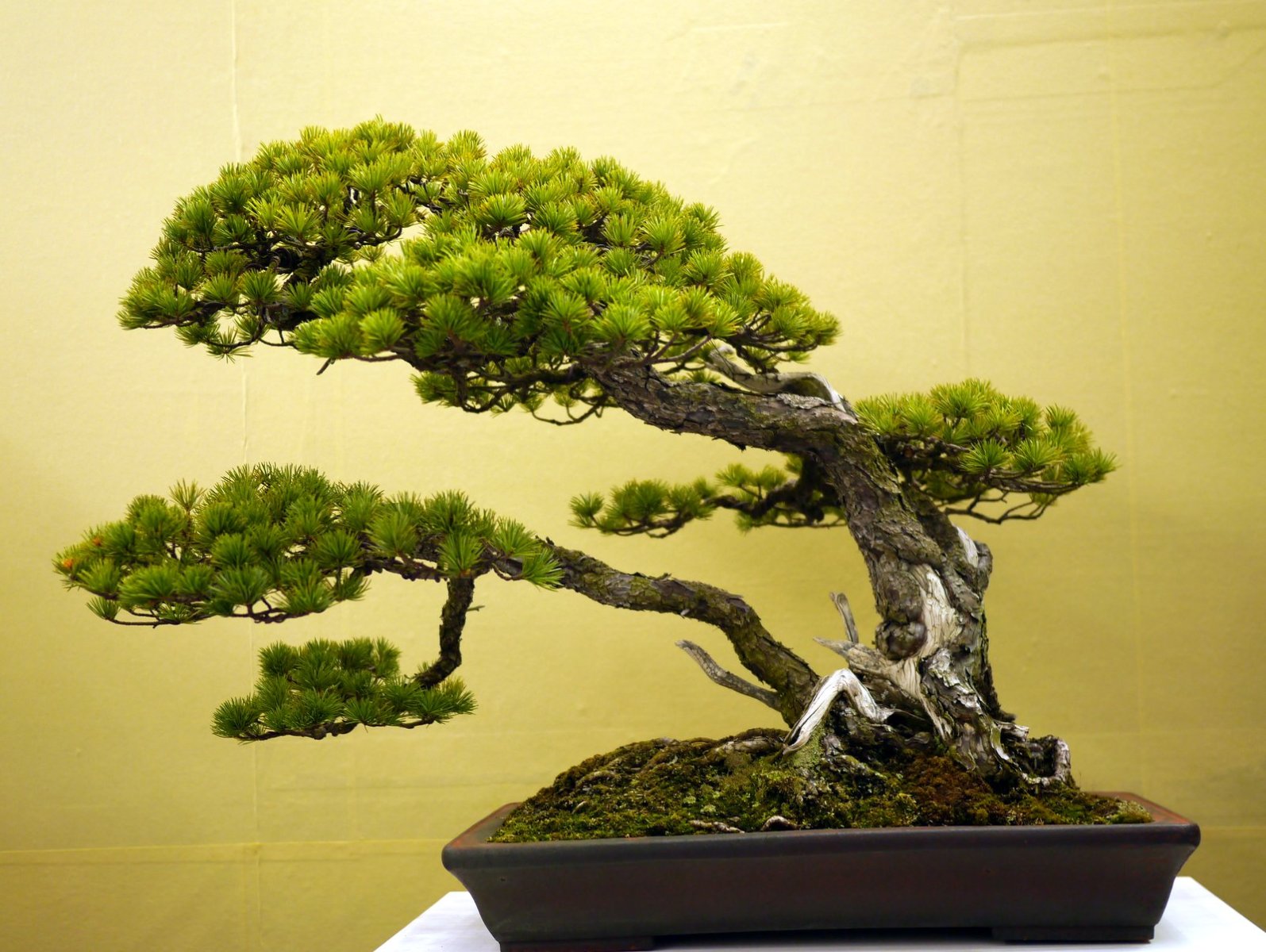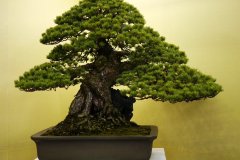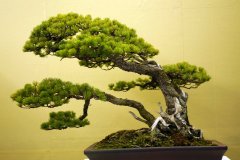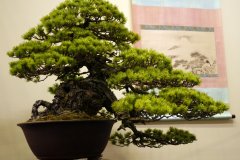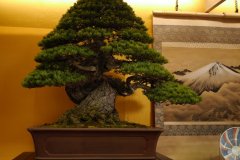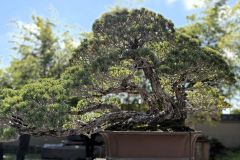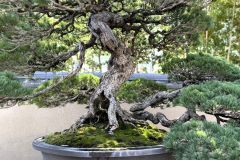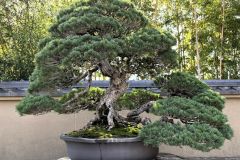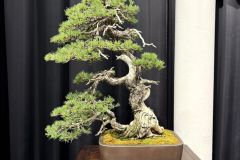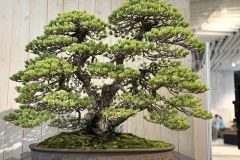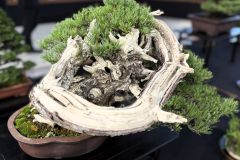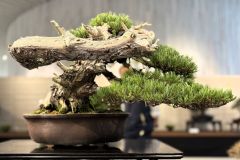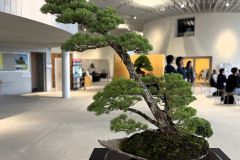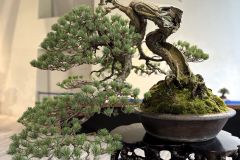About Japanese white pine
Japanese White Pine,goyo matsu
It is a type of pine oak and is characterized by the fact that it has five short leaves.
Although it is a strong tree, it grows slowly, and has been widely popular as a representative species of bonsai for a long time. The short, small and dense leaves blend in with all tree shapes and create a variety of flavors.
Shikoku Goyo from the Akaishi/Ishizuchi region of Shikoku, Azuma Goyo from Mt. Azuma in Fukushima Prefecture, and Nasu Goyo from the Nasu region of Tochigi Prefecture are famous for bonsai.
The eight-cluster variety, which produces many buds, is also popular, and the Nasu five-leaf variety “Zuisho” is especially famous.
In addition, Kinashi in Takamatsu City, Kagawa Prefecture is famous for producing many grafted Japanese white pine bonsai. This is a method of grafting Japanese white pine onto a fast-growing rootstock such as Japanese black pine to make slow-growing Goyomatsu grow faster.
Below are the characteristics of Japanese white pine bonsai.
Characteristics of needle leaf
- Short and soft leaves: The needles of Japanese white pine are shorter than those of other pines, about 3 to 5 centimeters long. As the name suggests, it is characterized by five leaves that grow in clusters. The leaves are soft and blue-green or blue-white, giving it a very delicate and elegant impression.
- Color of needles: The color of the leaves of the Goyo pine is a pale blue-green or silvery blue, and is shiny and beautiful. This unique color brings out the elegant atmosphere of Japanese white pine.
Slow Growth
Japanese white pine is characterized by slower growth than black pine. For this reason, Japanese white pine bonsai easily maintains its shape over a long period of time and can be cultivated over time. Because it grows slowly, the tree shape is easy to stabilize, making it suitable for maintaining elaborate shapes.
Characteristics of the trunk
- Powerful and dignified trunk: When the Japanese white pine tree becomes an adult tree, its trunk becomes thicker and has strength and dignity. As the bark of the trunk ages, it begins to crack and develops a unique texture, giving it the appearance of an old tree.
- White Bark: The trunks of mature trees have grey-white or light brown bark that becomes more attractive over time. This color harmonizes with the blue-green of the needles, giving the entire bonsai a sophisticated impression.
beauty of tree shape
- Easy to maintain a natural tree shape: The branches of Japanese white pine tend to draw natural curves, creating an overall soft and elegant tree shape. It is easy to adapt to a variety of bonsai styles, such as straight trunks (straight trunks) and patterned trees (curved trunks), allowing you to maintain a beautiful natural shape.
- Suitability for wiring: Because the five-yellow pine grows slowly, it is easy to trim the trunk and branches with wiring. Trimming the trunk and branches, especially when the tree is young, will give it a natural and elegant shape.
well-ventilated branches
The branches of the five-yellow pine are naturally spaced and grow easily, creating a well-ventilated appearance without crowding the branches and leaves too closely. This makes it easier to prevent the occurrence of pests and diseases, and to maintain a healthy condition.
Cold resistance and ease of cultivation
- High cold resistance: Japanese white pine is cold resistant, allowing it to grow well even in cold regions. Since it grows naturally in the high mountains of Japan, it is resistant to winter cold and is easy to grow outdoors.
- Hardy and long-lived: Five-leaf pine is extremely hardy and can last for decades or even centuries if properly cared for. Because of this longevity characteristic, Japanese white pine bonsai is often passed down from generation to generation.
Relatively easy to manage
Japanese white pine is said to be relatively easy to manage compared to other pines. Since the needles are not too dense, it is easy to perform tasks such as pruning and wiping, making it easy to grow even for beginners. However, it grows slowly and requires careful care.
Relationship with Japanese culture
Japanese white pine is often used in Japanese culture and gardens, and is also considered a sacred tree. It is particularly valuable as a high-quality bonsai, and has been used as a decoration in Japanese gardens and tea rooms since ancient times. In addition, Goyomatsu is considered a symbol of longevity and is respected as a tree that brings good luck.
Care guide of Japanese white pine
Place
Japanese white pine is a plant that likes sunlight. It is important to place it in a well-ventilated and sunny place. However, if exposed to too much direct sunlight, the leaves may burn, so in summer, move the plant to semi-shade or use a blackout net to soften the strong light.
Winter: Pine pine is cold tolerant, but potted plants require protection from strong winds and frost in cold regions. If grown outdoors, protect it from the wind and overwinter.
Spring and Autumn: Full, direct sunlight is best for growth during this time.
Summer: It is sensitive to high temperatures and humidity, so avoid direct sunlight and move it to a cool place. Ideally, it should be exposed to sunlight in the morning and shaded in the afternoon.
watering
Japanese white pine prefers dryness and is sensitive to excessive humidity. When watering, carefully observe the condition of the soil and wait until the surface of the soil is dry before adding plenty of water.
Spring and Autumn: This is the growing season, so water should be given in moderation. Water thoroughly after the soil is dry, but be careful not to keep it constantly wet.
Summer: In the dry summer, water especially in the morning and evening. Avoid watering during daytime high temperatures.
Winter: Reduce the frequency of watering during the dormant period to avoid drying out too much, but the key is to water sparingly.
Japanese pine and Japanese red pine are particularly dry among the pines.
Make sure the soil has good drainage as well. If you want to create particularly short leaves, water the plant sparingly. This is because they are more sensitive to overwatering than other pines.
fertilizer
Japanese white pine grows healthily by giving it an appropriate amount of fertilizer during the growing season. Fertilize in the spring and fall, but less during the hot summer months and during the dormant period in the winter.
Spring: Once new sprouts appear, use solid organic fertilizer or liquid fertilizer, about once or twice a month.
Autumn: Autumn is also a time of active growth, so fertilize to prepare for winter.
Summer and Winter: Do not fertilize during the hot summer months and winter dormancy.
Apply a nitrogen-based fertilizer during the growing season from spring to autumn, except during the rainy season and midsummer.
Replanting
Japanese white pine bonsai requires repotting once every 1 to 2 years when it is a young tree, and once every 3 to 4 years after it becomes an old tree. Repotting keeps the roots healthy and refreshes the environment inside the pot.
Timing: Ideally, repotting should be done during the dormant season in spring or fall. Replanting before the new buds begin to move will reduce the burden on the tree.
Method: Remove the pine tree from its pot, gently remove old soil, and prune out any long or tangled roots. Then, repot in new bonsai soil. Use soil with good drainage, and place gravel at the bottom of the pot to improve drainage.
In late March to early April, clean up the roots and repot in well-drained soil.
To improve drainage, it is necessary to increase the proportion of sand, but it is also important to use hard soil that will not crumble when watered. Also, when repotting, it is important to repot so that the roots can be seen clearly.
Pests
Japanese white pine is relatively resistant to pests and diseases, but spider mites, aphids, scale insects, and bollworms may occur. Pests are particularly likely to occur in environments with poor ventilation, so check the leaves and branches regularly and take prompt action.
Prevention: It is important to improve the shape of the tree to improve ventilation and create an environment where pests and diseases are less likely to occur. Also, occasionally use insecticides to prevent pests.
Diseases: Root rot and leaf blight may occur, but these can be prevented by preventing excessive humidity and ensuring good ventilation.
Spray chemicals to control aphids.
Winter insecticides and fungicides are effective during the winter, and aphids-specific pesticides are effective if outbreaks occur. In addition, be careful of red mites and bollworms.
Japanese white pine bonsai care tips
Bud Picking
From late April to May, when new buds appear, remove the buds to maintain a balanced growth. Pinch off only half to one-third of the strong buds. By plucking only the strongest buds, the other buds will grow evenly and the branches will become denser.
Gently pinch and twist the pieces with your fingers to make sure the remaining pieces are evenly distributed.
Bud cutting
Since Japanese white pine grows slowly, it is usually not necessary, but if it grows noticeably in May or June, cut it off with scissors, leaving only 3 leaves.
Cutting last year’s leaves
In November, remove the previous year’s leaves. It feels like the leaves are showing through, and the new shoots are also removed from the deep areas.
Cut leaving just a little of the base of the leaf to balance the overall appearance.
pruning
Prune the branches so that they become bifurcated during the dormant season or when repotting.
If you damage the trunk or branches during the growing season, resin will come out and make them dirty.
If there are three or more buds, cut the center and the buds facing up and down, making them into two on the left and right. Trim unnecessary branches with the assumption that they will split into two, and prepare the skeleton.
You can make gin by cutting the thick branches into small hollows and waiting for meat to be rolled into them, or by leaving the base of the branches short and stripping off the bark.
At the same time, wire the tree to adjust the overall shape of the tree.
Wiring
Wire hanging is done to adjust the shape of the Japanese white pine tree. When the branches and trunk are young, they are tied with wire to create a natural tree shape.
Suitable time: Wire hanging is generally done from autumn to winter. By avoiding the growing season, you reduce the risk of the wire cutting into the branches.
Techniques and precautions: Wrap the wire around the branches and trunk to shape the tree, but do so carefully and not too tightly. Check the wire regularly and be careful not to let it dig into the branches.
During the dormant period from November to March, trim the branches and leaves before hanging.
In addition to bending young trees to create a skeleton and lowering upward branches, it is also important to direct the buds that grow from side to side upwards (bud revitalization).
Japanese white pine grows its leaves horizontally, so the leaves left on the left and right sides need to be carefully adjusted so that the tips are pointing upwards to align them in the same direction.
Leave the wire on for about a year.
breeding
Seedlings are sold in winter, so you can either get them, store them in the refrigerator and sow them in March, or sow them and then place the pots outside where there is no frost.
Another method is to pick the fruit while it is still green and collect the seeds that pop out as they ripen.
In either case, the key is not to let the seeds dry out.
The following year, cut the tap root and plant in a pot.
Once you have a few plants growing, you can grow them in odd numbers and group them together to create a pine forest landscape and create an original pot.
It can also be grown by cutting or grafting.
If the graft is not in good condition, it is a good idea to regenerate it with a cut tree. The season is from February to March, and the roots should be rooted before the buds begin to move.

